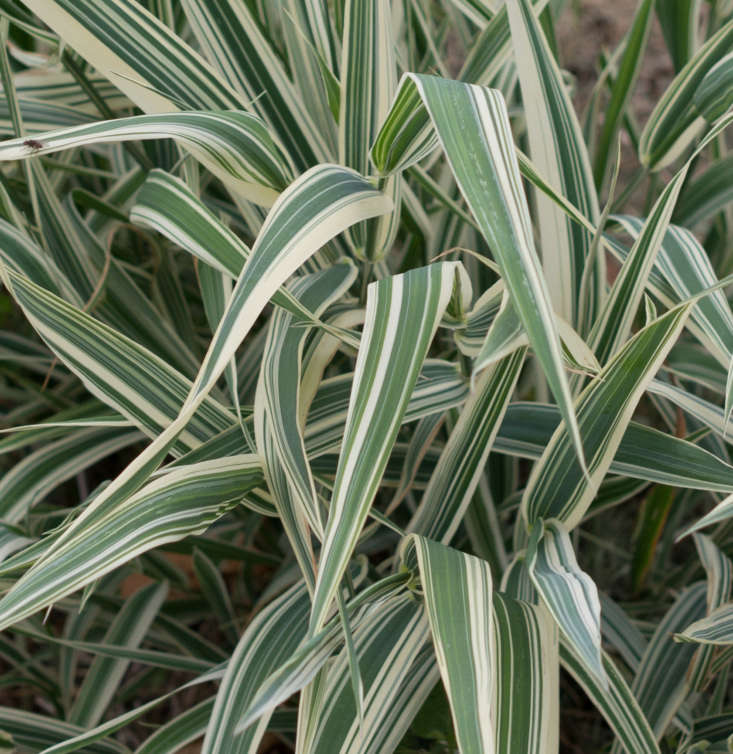Ribbon Grass, Phalaris arundinacea
Ornamental grasses have become the popular kids in class. Most of these leafy friends are perennial, low-maintenance, and attractive (looks only matter for me in plants–not people).
But grasses can have drawbacks; some will take advantage of situations to spread if given the opportunity. This is the case with rebellious ribbon grass. But if you grow it in a container–or if you’re looking for a quick-spreading ground cover, say, to stabilize a slope—ribbon grass is an attractive option.
Please keep reading to learn more about this grass:

Native to Europe and North America and hardy in USDA zones 2 to 9, ribbon grass grows to a height of about 2 feet. Because it spreads quickly through rhizomes, the width is variable. Planting it in a cultivated garden can be trouble, and planting outside of tended gardens in open spaces where it can choke out native wildflowers and grasses is not advised. Some states including Washington and Oregon have listed ribbon grass as an official noxious weed.
If ribbon grass is so invasive, why are we telling you about it at all? Its voracious nature can be useful in tough sites where nothing else seems to grow and a dense ground cover is desperately needed.

Ribbon grass accepts a wide range of soils from dry, to moist, to wet and in sunny spots to shade, which makes it seem like an attractive plant choice for a variety of situations. A tip to know is that if planted in the shade, the plant’s bullying tendencies are thankfully tamed.

Variegated varieties of ribbon grass are the more commonly found types in nurseries, and while some say they spread more than the parent type and some say they spread less, the verdict is not in.
Ribbon Grass Cultivars
Here are two ribbon grass varieties to know:
- Phalaris arundinacea ‘Picta’: Also known as gardener’s garters. This is a predictably spreading grass. Leaves are striped with pale green and creamy-white, and are useful for flower arrangements. Tan flower spikes appear in summer. The grass is easily divided in spring or fall. Craves moisture.
- Phalaris arundinacea ‘Feesey’: Foliage is variegated green and white (a bit more white than green), and it grows to a height of from 24 to 32 inches high. Cool spring and fall temperatures give the leaves a showy pink tint. Is considered the least invasive of the ribbon grasses.

Cheat Sheet
- Grow ribbon grass in containers to help prevent the it from spreading.
- Phalaris does well growing beside or even in shallow water, and is an option for planting around a pond or water feature.
- Plant ribbon grass in clumps, along borders where it is given permission to roam freely, or as container specimens.

Keep It Alive
- Little upkeep or maintenance needed for ribbon grass. Plus, Phalaris is virtually pest and disease free.
- The plant is best suited for moist soils in partial sun. If planted in full sun, leaf scorch can happen. If this occurs, simply cut back the leaves and fertilize; new leaves will emerge in a few weeks.
- In colder zones, mulch around the root zone to protect roots.
- Errant rhizomes can be controlled with pulling and digging. but to curb this invasive tendency plant in shaded areas.
For more growing tips, see Ribbon Grass: A Field Guide to Planting, Care & Design in our curated guides to Grasses 101. For more ways to use ornamental grasses in a landscape, read:
- 10 Garden Ideas to Steal from Superstar Dutch Designer Piet Oudolf
- Maiden Grass: A Field Guide to Planting, Care & Design
- Leaves of Grass: 9 Ways to Create Curb Appeal with Perennial Grasses
- Fountain Grass: A Field Guide to Planting, Care & Design






Have a Question or Comment About This Post?
Join the conversation